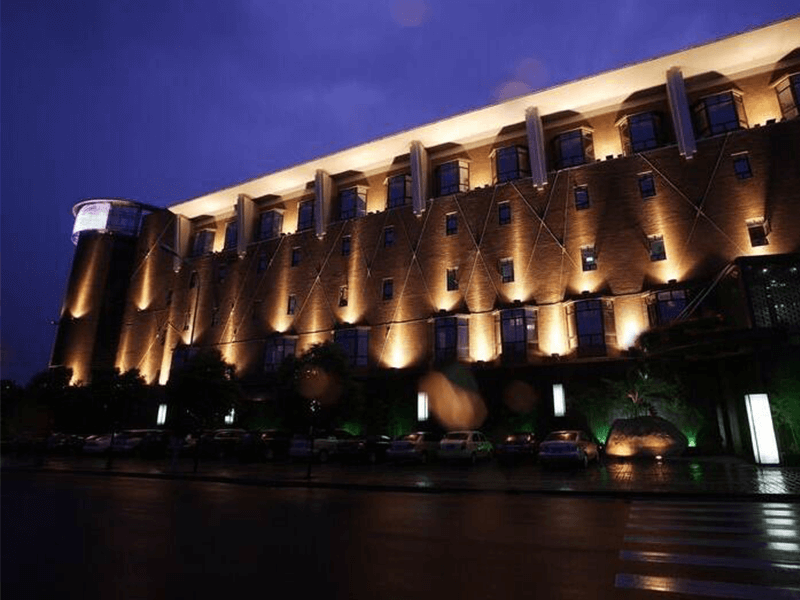When selecting a landscape lighting system, consider the distinct features of line voltage and low-voltage options to make an informed decision based on your specific requirements.
Line and low-voltage landscape lighting systems are popular choices, but the optimal decision depends on several factors. First, to determine the most suitable lighting system for your project, evaluate these general considerations before making your final choice.
A. Size and Layout of the Area to be Illuminated
The size and layout of the outdoor space play a significant role in determining the most suitable type of landscape lighting. For example, line voltage systems are typically better suited for larger areas that require brighter, more intense illumination. In contrast, low voltage systems are more appropriate for smaller spaces where softer, more subtle lighting is desired.
B. Desired Brightness and Intensity
Consider the level of brightness and intensity required for your outdoor space. If your primary goal is to provide robust and far-reaching light for security purposes or to illuminate large areas, line voltage systems may be the better choice. However, low-voltage lighting might be ideal if you prefer a more ambient, intimate atmosphere.
C. Energy Efficiency and Cost Considerations
Energy efficiency and overall costs are essential when choosing a landscape lighting system. Low voltage systems are generally more energy-efficient and cost-effective in terms of electricity consumption, while line voltage systems may incur higher utility bills. Additionally, consider the costs of fixtures, wiring, transformers (for low voltage systems), and professional installation services when comparing the two options.
D. Ease of Installation and Maintenance
Low voltage lights necessitate a transformer to reduce the standard voltage supply of 120/227V to 12/24V. Some fixtures come with an integrated transformer, while others need a separate transformer close to the circuit. This setup is safer and poses fewer hazards during installation.
Conversely, line voltage lighting does not need a transformer to decrease the voltage, simplifying the installation process. However, due to the higher voltage of 120 volts involved, line voltage systems require the oversight of a professional electrician to ensure safe handling and installation.
Evaluate the complexity and expertise required for installing and maintaining your chosen landscape lighting system. Low voltage systems are generally easier to install, often allowing owners to handle the process themselves. Line voltage systems, on the other hand, typically require the skills of a licensed electrician due to the higher voltage levels and associated safety concerns.
E. Local Regulations and Codes
Before deciding, research your local building codes and regulations related to outdoor lighting. Some areas may have specific requirements for the type, intensity, or installation of landscape lighting systems. Ensure your chosen method complies with these regulations to avoid legal issues or potential fines.
F. Safety Concerns
Safety should always be a priority when selecting a landscape lighting system. Low voltage systems offer increased safety due to the lower voltage levels, reducing the risk of electrical shock and fire hazards. Line voltage systems, while capable of providing brighter illumination, come with higher safety risks if not installed and maintained correctly. For example, consider the safety needs of your property, as well as the presence of children, pets, or elderly individuals, when choosing between line voltage and low voltage landscape lighting.
G. Light Output Quality
With their higher voltage lights, line voltage systems typically generate warmer and more diffused light output. In contrast, low-voltage lamps emit light closer to natural light, making more focused light beams.
The light quality of low-voltage LED lights is considered superior due to their reduced light scatter and improved optical control. They are primarily used in applications where aesthetics are of importance. With low-voltage LEDs, you can access a range of color temperatures and beam spreads, such as floodlights and spotlights, providing more versatility than line voltage lights, which offer limited options.
H. Cables and Connections
For line voltage systems to adhere to safety standards, wires must be buried at a minimum depth of 18 inches underground. Encasing the cables within a conduit can further mitigate potential hazards. Utilizing high-quality wires and connections with water-resistant and shockproof properties is essential.
Low voltage systems are safer and do not necessitate deep wire burial. However, for such systems, positioning the low-voltage wires just a few inches underground is usually adequate for most applications.
I. Relocation Of The Systems
Low voltage lighting systems offer greater flexibility, as they are not as permanent as line voltage systems, allowing for easy relocation. Additionally, incorporating another fixture into a low-voltage system is straightforward as long as the transformer can accommodate the extra load.
J: Voltage Drop
Voltage drop denotes the decrease in voltage encountered along a circuit of lighting fixtures. This phenomenon occurs in low-voltage lighting systems, as electricity dissipates during transmission. The voltage decreases as the cable’s length increases, resulting in fixtures receiving less power than needed for optimal output.
Position the transformer closer to the low-voltage landscape lights to solve this issue and refrain from using a daisy chain configuration. In a daisy chain setup, the first fixture typically receives more power than the next.
In the case of line voltage systems, adequate power is supplied to the fixtures, ensuring proper operation without the voltage drop issue.
For more even power distribution among fixtures in low-voltage lighting systems, it is recommended to divide the wire runs. Additionally, transformers can support a specific number of fixtures. For example, calculate the total wattage of all the fixtures you plan to illuminate to determine the appropriate transformer.
